L’abattoir.
From ‘Visionary Art in France’, The Visionary Review, Fall 2004:
Poumeyrol shares with Margotton a fascination for the interior landscape, where dimly illuminated grottos resonate with the remains of past epochs. And yet, his barren and abandoned spaces are often redolent with signs of the artists’ own lost memories.
In his early works, Jean-Marie Poumeyrol was recognized as a master of erotica, combining hallucinogenic and macabre imagery in an unparalleled manner. But, in his maturity, the artist has displayed a marked fascination for landscapes, particularly the enclosed spaces of sewers, industrial waste and disposal plants. Yet, the amazing accuracy and finesse of rendering which enlivened his early works has not left him and, if anything, only increased with age.
Horse.
Poumeyrol was born in 1946 and studied at the Academy of Fine Arts in Bordeaux. Upon graduation he already had a four year old son to support, and so began his illustrious career as a teacher of mechanical draftsmanship (his students learned to draw screws, bolts, etc).
This occupation was mercifully cut short when he was released from the educational system. In fact, art teachers had to pass tests given by the board to determine if they were skilled enough to teach drawing. At the same time that Poumeyrol’s erotic works were first seeing print and sought out avidly by collectors, he failed his art teacher’s exam—being given an ‘F’ for nude drawing…
Encouraged by this failure, he dedicated himself to painting and drawing full time, eventually creating a large body of erotica which have marked him ever since (along with Sibylle Ruppert) as one of France’s greatest artists in this domain.
Le Sabbat.
A self-portrait from this period reveals the artist as ambulant and a dreamer—travelling in a train compartment encumbered by photo snapshots of his more personal memories. In essence, the artist’s working methods are well represented by this image: his preference for the ‘in-between state’ of revery and melancholy:
“As long as I can remember” Poumeyrol writes, “I have been faithfully accompanied by boredom. These sad and useless moments, like a pleasant emptiness, have invented those strange chimeras which continually wander into my visual memory. With time, this uncommon state between memory and imagination has matured into a kind of contemplation, and I have become a great connoisseur of solitude, prefering that boredom which accompanies all my wanderings into a world delicious, extravagant and vain.”
Le Maitre de Manege.
Despite the lucrative gains to be made from erotic art, the painter gradually moved beyond the female form, finding a greater fascination in the interior spaces devoid of nudes:
“Over time,” he writes, “the women in my erotic works became more discreet and eventually disappeared, leaving only the faintest traces of their presence. Those interiors, no longer occupied by living beings, offered me in their stead a mysterious emptiness which invited all possibilities. A few remaining clues suggested their darker dimension.
L’Ogresse.
“From this moment on, I became fascinated by a series of rooms guarding their secrets. This metamorphosis in my work allowed me to explore man’s most primitive fears and anxieties: distress, obsession, solitude, darkness, enclosure, the passage of time, abandonment and death.”
A fine example of this new genre of work is his 1983 painting Hope. The slanting sunlight across the wall reveals an empty chamber where someone has been hard at work, building a model ship from balsam and glue. Erotic photos, reminiscent of Poumeyrol’s own early works, are taped against the wall. It is only when our eye wanders towards the barred door that we realize the hidden protagonist’s sad predicament, and why the sailboat offers him such a desperate and futile ‘hope’.
Canal asséché.
From a series of ‘chamber works’ such as these, Poumeyrol moved on to darker enclosures where any sign of humanity had long since left. Only the changes of the seasons, such as his 1994 series The Wells of Daylight, offer faint signs of movement, life and transformation. Here, movement comes from the different lights of the seasons that pour into the well.
Liberated entirely from the human form, Poumeyrol exalted: “I could explore caves, passages, depots, shelters, garrets, pantries, attics and all hidden places… Wooden doors, their locks unchained, swung open to reveal stained kitchen sinks, enamalled gas heaters and even a bed with dishevelled sheets in a narrow alcove.
Voie sans issue.
“These labyrinthine places were lit by small openings whose cruel light unmercifully exposed the objects within. Through these openings we could also make out the building’s surroundings – the vague terrain and industrial wasteland, the swamps and distant rooftops – all these ‘landscapes’ blanketed by snow or autumn leaves in the golden light of day’s end.”
At present, Poumeyrol lives in Pau in the Pyrenees, not far from Jean-Pierre Ugarte (indeed, the two have often exhibited together). His perspective has evolved once more, and his latest works offer more open spaces such as fishermans’ huts and shorelines.
L’amie.
At first glance, these may not seem to be ‘visionary’ at all. But, when considered in the context of his oeuvre, undeniable signs of continuity are present. The sailboat, for example, which the prisoner of Hope left half-built in his cell now appears on the open waters, a reality undreamed of.
And the artist himself continues to wander the shores, seeking those signs which trigger his own lost memories:
“After wandering long and alone” he recently wrote “through mysterious interiors, I managed to emerge into the outside world. Once again, a rich flow of memories revealed to me new paintings. I rediscovered in my mind those spaces which had fascinated me once before.
“These were born through a series of quick sketches, or else, from drawings made from memory (a little uncertain perhaps) where certain details survived with almost photographic precision. The passage of time makes the memory more selective, discarding all excess in order to reconstruct the most essential and meaningful.”
Elsewhere on { feuilleton }
• The fantastic art archive

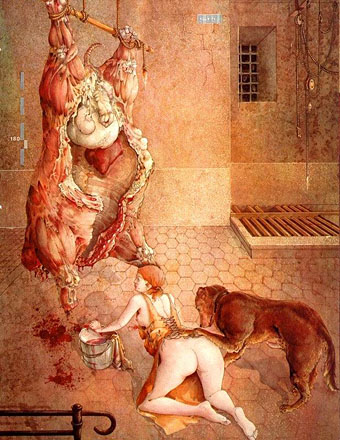

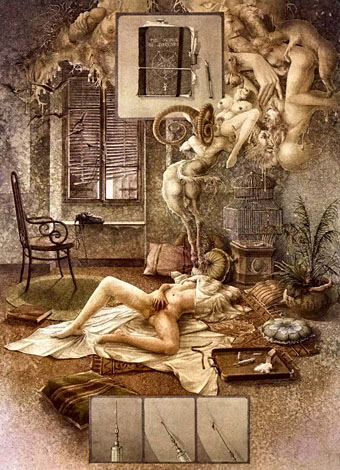
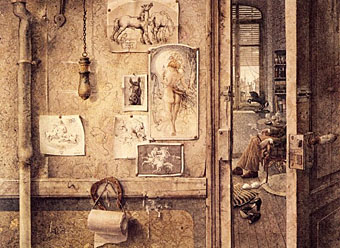
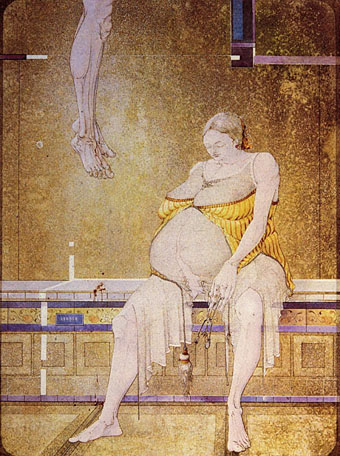
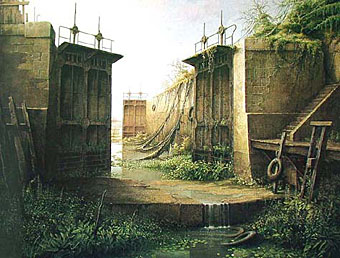
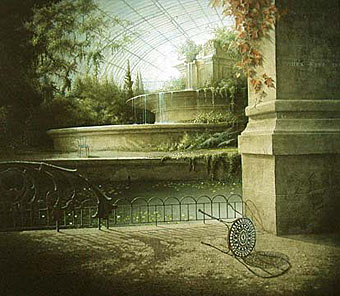
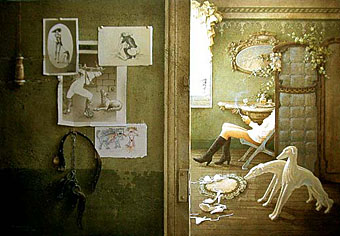
I’ve always benn enthralled by Poumeyrol’s work from the first time I saw it. I felt a wave from him that I felt when I created my own work, and to this day he remains a major inspiration. Brad Moore.
Thank you, new to me!
along with bellmer and balthus, the trinity of exquisite & delicious beauty and reality.